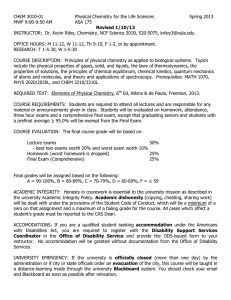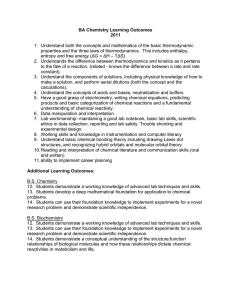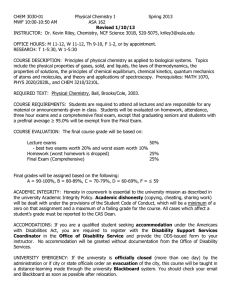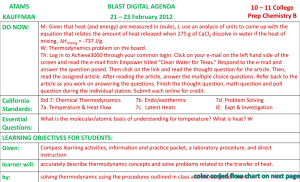CHEM 3510_Slattery
advertisement
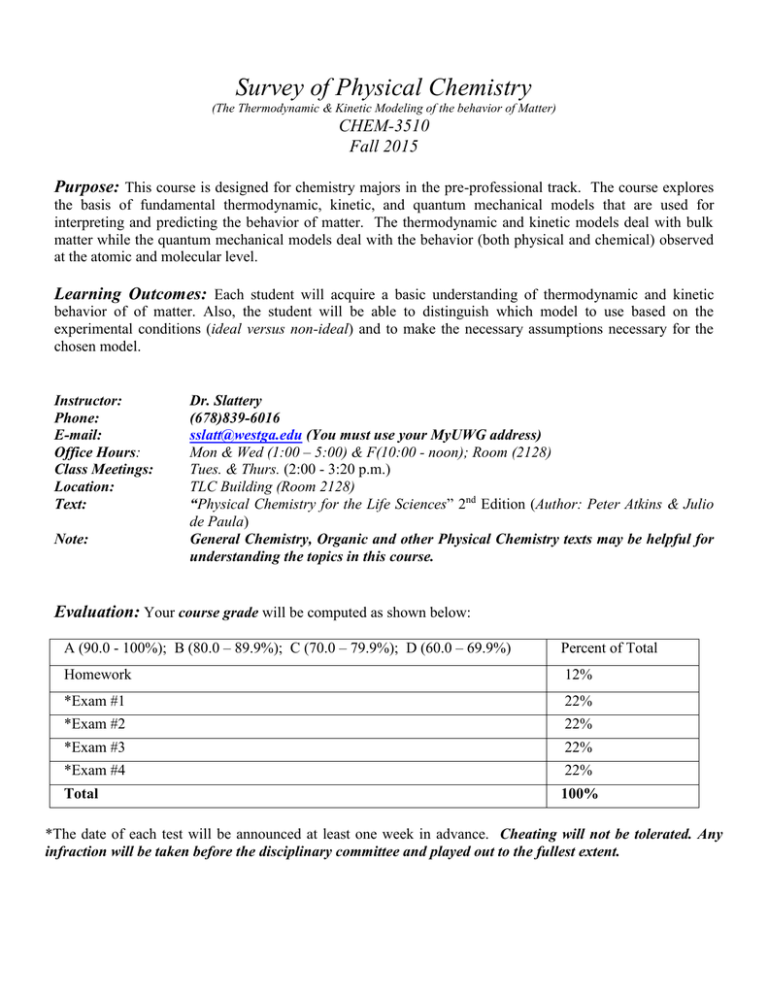
Survey of Physical Chemistry (The Thermodynamic & Kinetic Modeling of the behavior of Matter) CHEM-3510 Fall 2015 Purpose: This course is designed for chemistry majors in the pre-professional track. The course explores the basis of fundamental thermodynamic, kinetic, and quantum mechanical models that are used for interpreting and predicting the behavior of matter. The thermodynamic and kinetic models deal with bulk matter while the quantum mechanical models deal with the behavior (both physical and chemical) observed at the atomic and molecular level. Learning Outcomes: Each student will acquire a basic understanding of thermodynamic and kinetic behavior of of matter. Also, the student will be able to distinguish which model to use based on the experimental conditions (ideal versus non-ideal) and to make the necessary assumptions necessary for the chosen model. Instructor: Phone: E-mail: Office Hours: Class Meetings: Location: Text: Note: Dr. Slattery (678)839-6016 sslatt@westga.edu (You must use your MyUWG address) Mon & Wed (1:00 – 5:00) & F(10:00 - noon); Room (2128) Tues. & Thurs. (2:00 - 3:20 p.m.) TLC Building (Room 2128) “Physical Chemistry for the Life Sciences” 2nd Edition (Author: Peter Atkins & Julio de Paula) General Chemistry, Organic and other Physical Chemistry texts may be helpful for understanding the topics in this course. Evaluation: Your course grade will be computed as shown below: A (90.0 - 100%); B (80.0 – 89.9%); C (70.0 – 79.9%); D (60.0 – 69.9%) Percent of Total Homework 12% *Exam #1 22% *Exam #2 22% *Exam #3 22% *Exam #4 22% Total 100% *The date of each test will be announced at least one week in advance. Cheating will not be tolerated. Any infraction will be taken before the disciplinary committee and played out to the fullest extent. Tentative List of Topics to be covered: Assigned problems will be announced in class at the start of each chapter. The assigned problems will be turned in (on an announced day). O. Fundamentals and Properties of Gases (Chapter F at the very beginning of the book) A. Equations of State B. Kinetic Model of Gases C. Real Gases I. Thermodynamics: The First Law (Chapter 1) A. Conservation of Energy B. Internal Energy (U) & Enthalpy (H) C. Calorimetry D. Physical & Chemical Change II. Thermodynamics: The Second Law (Chapter 2) A. Entropy (S) B. Gibbs Free Energy (G) III. Phase Equilibria: Pure Substances (Chapter 3) A. Thermodynamics of Transition B. Phase Transitions C. Colligative Properties IV. Chemical Equilibrium (Chapter 4) A. The Equilibrium Constant (K) B. Response of Equilibria to Change V. Thermodynamics of Ion and Electron Transport (Chapter 5) A. Ion Transport across Membranes B. Redox reactions C. Applications of Standard Potentilas VI. Rates of Reactions (Chapter 6) A. Reaction Rate B. Temperature Dependence of Rxn Rates VII. Accounting for the Rate laws (Chapter 7) A. Reaction Mechanisms B. Reaction Dynamics VIII. If Time has not run out, then what’s next? Quantum theory



